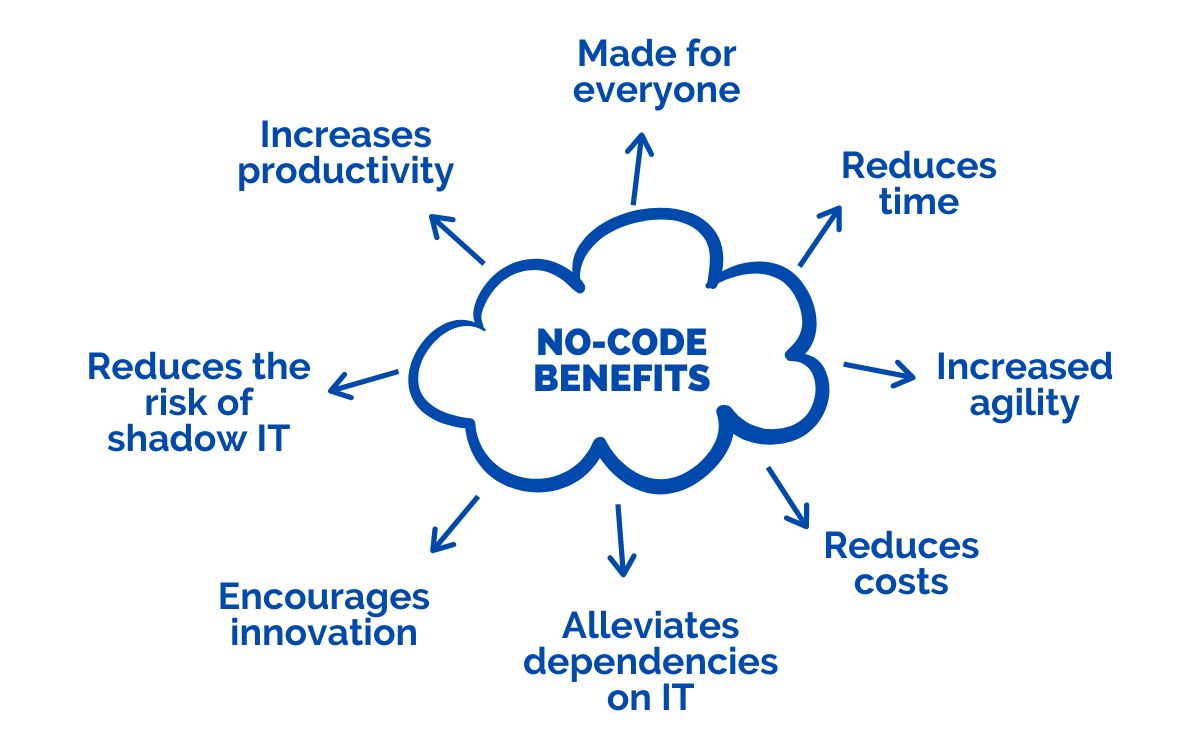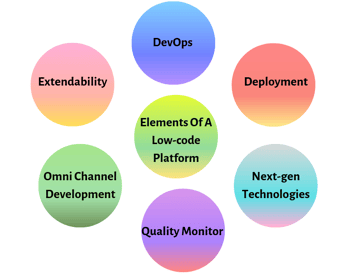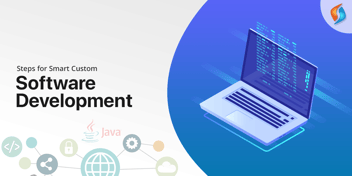Low Code and No Code: The Power-duo You Need in 2024
Have you ever wondered how low-code and no-code platforms benefit your business? Then, this is your cue to learn the concepts to the fullest. Read on to learn everything about low-code and no-code platforms—their origin, the architecture, and the challenges.

Have you ever dreamt of creating innovative applications but lacked the coding skills?
Low-code and no-code application development platforms are here to turn that dream into reality. These platforms empower both citizen developers (business users with limited coding experience) and professional developers to build applications faster and easier.
While they are similar in many ways, there are also some differences between them. A low-code platform usually involves some degree of coding, whereas a no-code development platform is entirely based on visual interfaces.
By the end of 2024, 80% of non-IT companies will be adopting LCNC. Here’s your opportunity to do the same!
A Peek into the Past: How Low-Code/No-Code Evolved?
Low-code and no-code platforms have a deep history rooted in the early 2000s. First came RADs, which are touted as the predecessors of a low-code platform. Slowly, more and more people warmed up to the idea of just using “drag and drop” components instead of typing out umpteen lines of code.
Bubble was the first no-code development platform that came into existence in 2012.
Principles of a Low-Code Development Platform
Here's a breakdown of the underlying principles that make LCNC development tick:

-
Model-driven Development
Imagine those Lego blocks you used to play with in your childhood. A collection of Legos would ultimately give way to a house or a space shuttle. Similarly, Low-code platforms provide pre-built components that you can assemble to create your application, fostering a visual approach to development.
-
Agile Environment
An agile environment is very important for firms with a purpose-driven development plan. These platforms seamlessly integrate with agile methodologies, allowing for rapid prototyping, testing, and deployment cycles.
-
User-centric Design
A low-code development platform can rapidly prototype software. As we know by now, low-code platforms can save users a lot of time, so they can use their brainstorming skills to make better decisions, like deciding on the UX. The pre-built features, like in-built templates, dashboards, and progress tracking bars, also help to a good extent.
Related Read: Tips for Choosing the Right Custom Web Development Company
-
Governance
LCNC platforms offer features like role-based access control, ensuring data security and streamlining workflows within organizations.
-
Multi-user Development
This is another game-changing advantage developers get when they choose a low-code development platform. This is a boon, especially in remote work settings. With multi-user development capabilities, real-time collaboration on projects becomes a breeze.
Principles of No-Code Platform

-
Streamlining The Cycle
Using a no-code platform for application development helps the citizen developer streamline every stage of the application development cycle. Right from the documentation part, which is very technical and involves humongous volumes of data. Capturing the business logic happens seamlessly and in minimal time. Also, breaking down large chunks of code into smaller chunks for the rest of the team to decipher is an easy process if one is using a no-code software.
-
Minimal Complexity
This principle is based mainly on basic human psychology and behavioral economics. Sometimes, when a person knows too many things, it is normal for them to dump that information in unnecessary places, and this might lead to the stuffing of information.
These platforms prioritize user-friendliness, minimizing the need for complex coding knowledge. This fosters faster development and reduces the risk of errors. In this case, the solution is to stick to a simple no-code development platform that allows citizen developers to develop the applications easily.
-
Speed
With reduced development time and a shortened application cycle, it becomes possible for software developers to release the features easily to the audience. A no-code platform gives users the option to modify features even after the release, acting much like an AI app builder. So, there’s no need to jam-pack all the features or components in the first release itself. This simplistic process enables the firms to progress swiftly along the organizational roadmap without any concerns.
Choosing the Right Platform: Low-Code vs. No-Code
While both LCNC platforms aim to simplify development, they cater to different needs:
Low-Code Platform

- Ideal for: Complex applications requiring customization and integration with existing systems.
- Target Audience: Often the choice for enterprises with in-house development teams who can leverage the platform's:
- Greater Architectural Range: Compatibility with various platforms, scalability options, and the ability to add custom code and plugins for a more tailored fit.
- Open System Design: Many low-code platforms utilize open-source code, allowing for greater transparency and potential community contributions.
No-Code Platform

Source: Quixy
- Ideal for: Building simple applications or prototypes where speed and ease of use are paramount.
- Target Audience: Citizen developers with minimal technical expertise can leverage no-code platforms effectively due to their:
- Closed System Design: A simplified interface with pre-built features and functionalities minimizes the need for coding knowledge.
- Faster Deployment Speed: Highly configurable features and minimal customization options lead to quicker development and deployment cycles.
Here's a table summarizing the key differences between Low-code and No-code:
| Feature | Low-Code | No-Code |
|---|---|---|
|
Complexity of Applications |
Handles complex applications |
Ideal for simple applications and prototypes |
|
Customization |
Offers extensive customization options |
Limited customization options |
|
Integration |
Integrates with existing systems |
Limited integration capabilities |
|
Technical Expertise Required |
Requires some development knowledge |
Minimal to no technical expertise is required |
|
Development Speed |
Faster than traditional coding but slower than no-code due to customization options |
Fastest deployment due to pre-built features |
|
Target Audience |
Enterprises with development teams |
Citizen developers |
|
Open vs. Closed System |
Often utilizes open-source code |
Closed system with limited access to underlying code |
Unveiling the Potential: Use Cases of LCNC Platforms
Although the common purpose of a low code, no code platform is the same—simplifying application building for citizen developers—they differ vastly in their use cases. Let us understand this by citing a few examples.
Low Code Use Cases
- Deep Dives: Analyze customer behavior, market trends, and operational efficiency with custom data collection and visualization tools.
- Industry-Specific Solutions: Craft loan application portals (Finance), patient portals (Healthcare), or production tracking apps (Manufacturing).
- Marketing Automation: Personalize email campaigns or social media content based on customer segmentation.
- Enhanced Collaboration: Design internal communication platforms for knowledge sharing, project management, and document approvals.
No Code Use Cases
- Rapid Prototyping: Validate app ideas with functional prototypes before full development.
- Internal Tools: Build onboarding processes, expense reporting, or knowledge base applications.
- Customer Engagement: Develop chatbots for basic inquiries or self-service portals for order tracking and knowledge base access.
The Power of LCNC: Advantages Abound
-
Productivity
Pre-built components and visual interfaces in LCNC platforms accelerate development cycles, freeing devs for complex tasks like system integration and API development.
-
Business-IT Bridge
Low-code and no-code applications provide a very user-friendly interface to both citizen developers and the IT team. The former can use the “drag and drop” options to create the MVP or prototype of the application and test various features.
The experienced IT team, on the other hand, can handle the more technical aspects, such as integrating the software, agility, ecosystem, etc. In this way, both sides can work collaboratively and efficiently to develop an interactive solution.
-
Citizen Developer Power
LCNC platforms empower citizen developers with minimal coding experience by offering intuitive interfaces and pre-built functionalities. This unlocks a wider talent pool for faster development.
Related Read: How Low-code App Development Helps Develop Smart Mobile Apps?
-
Improved Customer Feedback
If you want a loyal customer base and reduced friction in the sales funnel, a low-code or a no-code platform is the ultimate solution to your troubles. Citizen developers can develop applications in no time. Also, low-code applications enable firms to resolve their customer issues in the fastest time possible. This really helps in building brand authenticity and trust.
-
Cost-effectiveness
LCNC platforms minimize coding needs, reducing development time and resource allocation. Additionally, their modular design often requires less maintenance compared to traditional applications.
A Reality Check: Considering the Disadvantages
-
Rise of Shadow IT
LCNC platforms can inadvertently foster shadow IT due to their ease of use. Unmanaged application development by non-IT personnel poses security risks and integration challenges. Mitigating strategies include robust governance models, access controls, and centralized application repositories.
-
Limited Customization Options:
LCNC platforms often prioritize pre-built components over deep code customization. This can restrict functionality for specific use cases. Evaluate platform capabilities against your unique needs, considering integration with APIs or custom modules if necessary.
-
Over-Dependence on The Vendor:
LCNC platforms can create vendor lock-in, limiting flexibility in switching providers or integrating with external systems. Before deployment, assess vendor openness to APIs, data portability options, and the availability of alternative solutions.
-
Security Concerns:
LCNC applications inherit security vulnerabilities from the platform itself and user awareness. To minimize risk, implement security best practices like role-based access control, regular penetration testing, and user training on cybersecurity threats (phishing, social engineering).
Making a Choice: Low-Code or No-Code?
Whether to use a low-code platform or a no-code development platform for your firm actually depends on a lot of questions like-
- Project Complexity: Complex applications with specific functionalities might necessitate low-code development.
- Development Team Expertise: If you have a team of developers, a low-code platform might offer more flexibility. For citizen developers with minimal coding experience, no-code is a viable option.
- Budget- No code is usually suitable for firms with a lower budget than the ones opting for low-code applications.
Getting Started With LCNC Development
While we all agree that low-code and no-code applications are a relatively new concept, there’s no doubt that they make our lives easier. If you are a citizen developer looking to build your application using low-code or no-code, it’s always better to consult a custom web development company like Signity Software Solutions with years of proven expertise.
A dedicated firm will not only guide you through the numerous use cases but also suggest ways to mitigate the associated risks. The goal is to develop the most simplistic applications in the shortest time possible, and a low-code, no-code platform is certainly a boon in this regard!
The Future of LCNC Development
The future of LCNC development looks bright. As artificial intelligence (AI) and machine learning (ML) become integrated into these platforms, we can expect even more powerful features and capabilities. This will further empower citizen developers and streamline the entire development process.
Low-code and no-code application development platforms are revolutionizing the way we build software. By offering a user-friendly and efficient approach, LCNC empowers a wider range of people to bring their app ideas to life.















